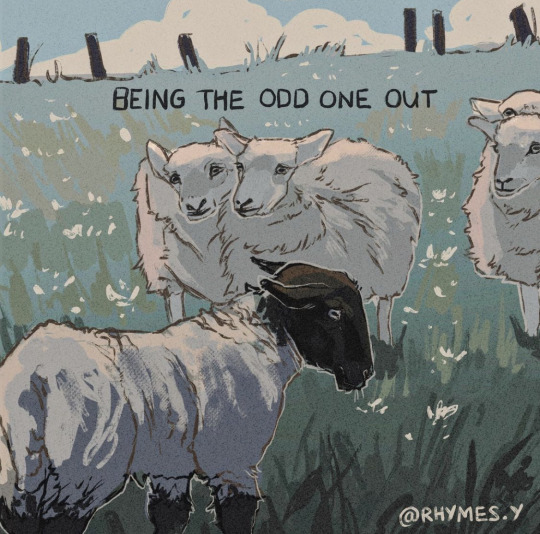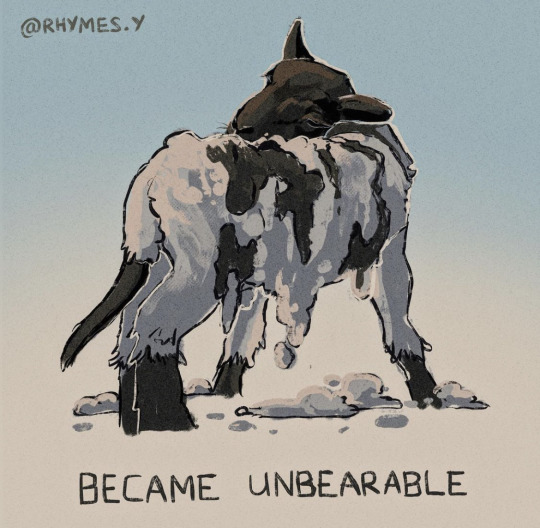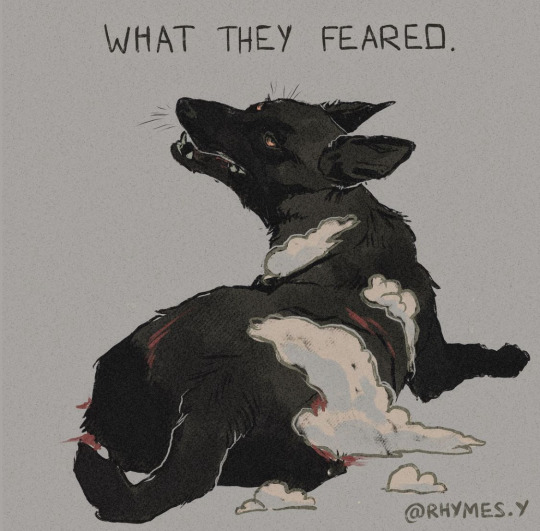Text
book quotes that i will never recover from
"he is half of my soul, as the poets say. " - song of achilles
"write me a letter telling me how to live the rest of my life without you." - how to make friends with the dark
"they were my birthday presents." - shatter me
"she had realized that she had forgotten the precise blue of his eyes and the depth of his laugh." - clockwork princess
"my name is sam cortland... and i will not be afraid." - assassin's blade
"you chose me four years ago. would you choose me still?" - these violent delights
"we were all supposed to make it." - crooked kingdom
"i remember everything." - the invisible life of addie larue
"come home and shout at me. come home and fight with me. come home and break my heart, if you must. just come home." - cruel prince
"i wasted all those yesterdays and am completely out of tomorrows." - they both die at the end
"you hated the idea of me." - the final gambit
"bob says hello." - house of hades
"abuse can feel like love. starving people will eat anything." - nightfall
"i missed you only with an ocean between us. but if death was separating us... i would find you." - queen of shadows
"i loved him. i love him. as best i could." - we were liars
"i'm the villain, even in my own story. but you were supposed to play a different role." - finale
"i will find you again in the next world—the next life. and we will have that time. i promise." - a court of wings and ruin
"i spent half of my time loving her and the other half hiding how much i loved her." - the seven husbands of evelyn hugo
63K notes
·
View notes
Text
im like if a girl was {undefined variable}. im like if a girl was [fragment missing]. im like if a girl was (editor’s note: the author’s invocation of the word “girl” in this context is idiosyncratic, perhaps metaphorical) im like if a girl was im like if a girl draft deleted! im like if a girl You have reached your free article limit! Subscribe now to continue reading. im like if a girl was [THREAD LOCKED] im like if a girl (ENDING EXPLAINED!) im like if a girl Unusual activity detected, please highlight all the pictures of bicycles. im like if a girl I don’t respond to prompts that could be deemed offensive, and so I am unable to carry out the request. im-like-if-a-girldeactivated03092023. im like if a girl we are unable to take your call at the minute. im like if a girl isn’t registered under that name. im like if a girl could give you her date of birth. im like if a girl oh yes we have you under […]. im like if a girl LOST CONNECTION
52K notes
·
View notes
Text
Top-Tier Villain Motivations
They will be safe. It doesn't matter who else or what else burns as long as They will be safe.
I will be safe. The hunger and the cold will never touch me again.
Fuck any bitch who's prettier(/cooler/better-liked/better at making dumplings) than me.
Yes, Master
Love me. Love me. Love me. Love me. LOVE ME!
I know the terrible things these so-called "heroes" will do if I don't stop them (<- is absolutely wrong)
I don't want a better future, I want a better past!
No other way to get performance art funded these days
48K notes
·
View notes
Text
Motivation For Writing
Getting Off Your Butt:
1. Aestheticise it. Let the light in through the curtains, turn on your fairy lights, lay a blanket over your lap, light some candles, whatever you need to do to feel like a writer. The right vibes can go a long way
2. Picture that one scene. There’s almost always a moment you’re super excited about that basically inspired the whole book. Picture it, play it out in your head in full cinematic fanfare, gush to yourself about how cool it is and how everyone will love it, picture a future fanbase going nuts for it. You might get excited enough to go back to writing
3. Set a word count goal. During NaNoWriMo this year I think I wrote more than I ever have in one go. The thing that kept me coming back was the desire to not fall behind. I ended up with ~45K words after some complications irl caused me to drop off in the final few days, and that’s all just because I was adding up the 1667 a day word count goal and realising where I needed to be at to keep up. I definitely can’t stay as rigid as I did with 1667 words every single day, but seeing that you’re only a few hundred words off of a goal is super motivating - just be sure to set realistic, easy to achieve parameters for just general use, like 1000-2000 words per week. I know 200 words per day is a popular one for people trying to establish a writing routine that can’t dedicate forever to the craft
Maintaining Motivation:
1. Writing sprints. Writing sprints are a godsend for me, I like to set myself up in the living room with Abbie Emmons’ writing sprint video on. The video lasts two hours and is broken up into two parts; 25 minutes to write and 5 minutes for breaks between writing, so four 30 minute sprints overall. Having the timer and countdown with peaceful music and an aesthetic background is both relaxing and encouraging, as well as giving me a specific time for how much longer I have to push through. It’s easier for me to say “Okay, only ten more minutes, then you can take a break” then it is to say “Just keep going, we’re not stopping until I say so” which is too arbitrary for my brain to accept
2. Give yourself a choice. If you’re struggling to keep your focus, come up with a finish line and tell yourself you don’t have to do any more work once you’ve reached that point. Finish the paragraph, go for another five or ten minutes, keep it up until your next scheduled break. Whatever sounds realistic and doable without being overwhelming. And once you’ve met this goal, ask yourself if you still want to stop. With any luck, you’ll have gotten back into the zone and will choose to keep going. Maybe you’ll want to take a quick break but you’ll come back later on. And maybe you’ll decide that now actually is a good stopping point. Just remember that, if you do still want to stop, don’t force yourself to keep going. You can’t strike deals with yourself if you know you won’t keep your word and all you’ll end up doing is burning yourself out, which will lead to even less writing getting done
3. Try a new angle. If you can’t be bothered to write anymore, is there anything else you can do for your book? Plotting, editing, worldbuilding, character sheets, one-shots all that sort of thing can still be productive for your book while still being different enough to give your brain a slight respite. It also means less work in that particular area later on
Afterwards:
1. Organise. Clean up your workspace and put everything away so it’s nice and neat for when you come back to it. Or if you don’t need to pack things out the way, set it up in an aesthetically pleasing way so it will tempt you back next time. Let it give you the writer vibe
2. Take care of yourself. Get a drink, have a snack, walk about, stretch your limbs, take a breath, cuddle your pet. Something that gets you away from straining your eyes looking at text for a bit. This is also a good time to reward yourself if positive reinforcement is something you use on yourself. If you always feel shitty after your writing sessions, you won’t want to go back to it
3. Positive reflection. Make sure to tell yourself you did good, even if you didn’t get as much done as you would’ve liked or it isn’t up to a standard of quality you’re aiming for. That can all be fixed later on, and you’re infinitely better off than you would’ve been if you didn’t do it. Be proud of yourself. Tell yourself you’re proud of your hard work and your dedication and your effort. Remind yourself that this is a fun thing you like to do. Marvel over how insane it is that you’ve gotten this far - not many people do - and that you’ve got all this tangible work to prove you’ve accomplished something so many people wish they could pull off. If this isn’t fun overall, there’s no point
520 notes
·
View notes
Text
"he said this" "she said that" ok and??? The universe said I love you?? And the universe said you have played the game well?? And the universe said everything you need is within you??? And the universe said you are stronger than you know??? And the universe said you are the daylight?? And the universe said you are the night?? And the universe said the darkness you fight is within you??? And the universe said the light you seek is within you??? And the universe said you are not alone???? And the universe said you are not separate from every other thing?? And the universe said you are the universe tasting itself, talking to itself, reading its own code???? And the universe said I love you because you are love?????????????
7K notes
·
View notes
Text
Outline a Rough Draft of Your Novel
This is a worksheet for people like me, who see the dreaded Triangular Mountain of Plot Points and curl up inside. Stories don’t always need to form the shape of a triangle with their conflict, climax, and resolution.
Try these steps out to make a rough draft of your first plotline.
(I say first because most writers always go back and add or delete ideas along the way! What you plan with these steps doesn’t have to be permanent.)
Step 1: Set the Scene
Filling out these points will expand your story and make it seem more real in your mind, if it isn’t something that you have a good concept of already.
This is the step you’ll want to return to if you’re struggling to write later because there aren’t enough concrete details about your fictional world/cast of characters.
My story takes place in (city, country, kingdom, world, universe): __________
The year is: _____
My character(s) is(are): __________
Their current situation is: __________
Step 2: Pinpoint Your Theme
Stories have themes, even when you don’t realize it. Concrete themes, like survival, love, or death, are more straightforward. In Room, the story is about how the main characters survive through a testament to their love for each other.
Or you could want to write about something more fluid, like the experience of growing up. A coming of age theme (like in The Perks of Being a Wallflower) will demonstrate how the young protagonist matures in their identity or their world view by the end of the book.
Whatever your theme is, write it at the top of your planning page or document. I’ve found that I have to return it while outlining when I feel lost or stuck. It’s easy to wander away from your theme when you get excited or if it’s been a while since you got your initial idea. (And you’ll need a concrete theme if you decide to pitch your manuscript to literary agents, so you’re saving your future self a bit of extra work.)
Step 3: Create Your Initial Conflict
Every story needs an initial conflict to kick things off, even if your outline would look more like the line on a heart rate monitor than a triangle. Think about Georgie sailing his boat down the street and going missing in It or Prim getting selected at the reaping in The Hunger Games.
__________ will happen to X character(s) and cause them to react by doing __________.
Because my character(s) had that reaction, the world starts changing by __________.
Step 4: Make Each Chapter a Bullet Point
Chapter One
This will likely include all of the information you planned from Step 1 and 2. The initial conflict is often the hook at the end of the first chapter, but it can happen before or after too!
Chapter Two
When my character sees the world changing in the above ways, they respond by doing __________.
Chapter Three (etc.)
Keep in mind that each chapter needs to have a point that drives your character or plot towards your main theme or conclusion.
Don’t panic if you don’t have all the details of your plot in mind yet! Remember, this bullet point stage is for rough draft planning. You could come up with five chapters that end the book. That’s awesome—go write what you plan!
You’ll get more ideas as you start writing. When inspiration strikes, jump back into the heart of your bullet point list and thread ideas in wherever they fit best. That’s what’s so great about working with a list form instead of writing everything in a simple shape. You have endless room and the eternal ability to expand your fictional world.
Sometimes this part of novel outlining takes me a month. Sometimes many. It depends on how vivid the story is to me when I think about it.
Most of the time, I let my outlines marinate. Make this bullet point list or one without chapter headers. Open your notes when you get an idea for a scene detail, a conflict, dialogue, or anything else. When you want to organize, you’ll have pages of thoughts that came to you while you were working out or grocery shopping. Use them as inspiration to piece together a longer story (or throw out the ideas that aren’t as great as you thought they were).
Step 4: Read Through Your Outline
You’ll have quite a few things going on within your outline at this point, so review everything when you feel like you’ve reached the halfway point or end of your story. You’ll get a feel for the flow, see if the thematic threads or character arcs connect where they should, and spot gaps that need more details.
Writers who don’t typically plan—don’t worry. Read through your bullet point list to refresh yourself.
If you don’t get any ideas like the list above, just start writing. You can update your list with what you write in each chapter as you go, just so you’ll always know where you are in the plot when you sit back down to write again.
Step 5: Check Your Theme or Point
After reviewing your outline, consider if it carries and fulfills your theme or main point that you listed at the top of your document. It should! That’s what creates the bliss of closing a book and knowing every loose end got tied up.
Step 6: Write Your Heart Out
Writers who haven’t written with an existing outline might panic a bit here too. Let me set the scene—when I have a working bullet list outline, I keep it open in its own tab. Then I have another tab with my manuscript.
I usually split my screen in half so I can see both documents, but the manuscript takes up more space so I can see the entirety of each paragraph. I review where I’m at in my outline, then jump into the writing process. The outline is always a click away if I can’t quite remember where the chapter is going, what specific details I planned, or where it’s supposed to end.
Optional Step: Include a “Possible Plot Points” Section
I love letting outlines sit so I can add to them over the course of weeks or even months. At the same time, it creates tons of random ideas that don’t always fit into my outline when I sift through everything and make chapter headings.
The ideas or details that don’t make my outline go in a separate section that I call “Possible Plot Points.” If a chapter is noticeably short, boring, or just plain missing something, I’ll go back to this section. There’s usually something that I can add into my current chapter. Most of the time, I get inspired by the old ideas.
Nothing you write down during your outlining is a waste! Save it all. The stuff you don’t use will become useful later, I promise.
***
Try this version of outlining for yourself! Whether you’re plotting on paper or your computer, outlining is an immense help in writing long-form stories or books.
2K notes
·
View notes
Text
on plotting: the rule of three
what is it?
about the rule
other people might call it something different, but for me, the rule of three in fiction writing is a foreshadowing tool. to persuade your audience of something and make a twist or story element feel earned, you hint at it at least three times.
things are appealing in sets of three. if something happens once, it’s random, twice is coincidence, and three times is a pattern.
a brief guide
on using the rule
use showing over telling. the whole point of this rule is to convince your reader of something, and unfortunately you can’t “trust me bro” your way into establishing key information.
look into types of foreshadowing. you can call attention to these scenes using strategies like symbolism or irregular description, in which you call unusual attention to a seemingly insignificant detail.
let’s say you want to convey that a specific character is untrustworthy. let’s break this down into three scenes.
first, let’s say we catch this character sneaking out after they said they were going to bed. this raises questions of why they lied and what they’re actually doing. using a direct scene like this first will alert the reader and make them more likely to notice less obvious information later on.
second, we maybe include a scene where they directly contradict something they said earlier. it helps if it’s a minor detail that wouldn’t make much sense to lie about, such as their birthday.
the third scene is the one that should cement this item in your readers’ minds. maybe this scene is a step above the others; maybe this time, the character tries to pit everyone else against each other. maybe they steal or participate in a much bigger lie.
if you’re building up to a betrayal, this can either be the betrayal itself or the scene directly before.
use this rule in moderation. if you bring up something too many times without solidifying it, the story risks becoming repetitive.
brainstorm, create brief outlines of the scenes you want to include, and then decide where in the story these scenes should go.
when i’m using the rule of three to revise, i create a list of all the scenes and chapters i currently have and tack the new scenes on as sticky notes where i see fit.
this may be a bit excessive.
instead, you might consider creating a rough outline of the plot or plots you want to write and jotting down a list of scenes according to where in each arc they should fall, or simply having a document or notepad where you write down ideas.
in action
media examples
the hunger games. the poisonous plant nightlock is specifically mentioned three times, once in the capitol and twice during the games, before it is used for a major plot point.
the karate kid. the crane kick technique is introduced early on, and there are scenes where the main character specifically practices his crane kick before it wins him the match at the end of the film.
---------------------------
thanks for reading! hope this was helpful :)
tip jar | so what even is radio apocalypse?
123 notes
·
View notes
Text
Me when I plan out a story and want to tell everyone
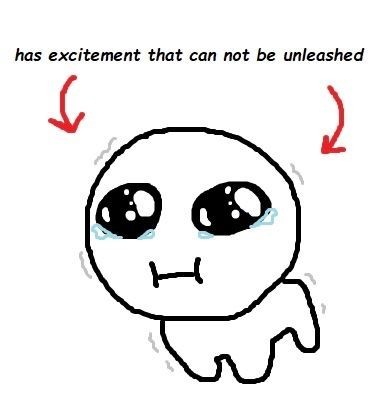
69K notes
·
View notes
Text
The Gun In This Guide Does Not Go Off
Hi yall, sorry for the late post this week! I'm running this blog by myself, so if you are interested in helping mod this blog or write guides, please fill out the mod form linked in the pinned post! If you have anything you want to see covered or specific questions answered, please don't hesitate to send an ask! Anon is on.
Onto the guide!
This week I want to talk about foreshadowing, what it is, why incorporate it, and how!
What is foreshadowing?
Foreshadowing is an event, line, dialogue, or other element of a story that alludes to or predicts a future event. Foreshadowing can be overt or covert, and it can appear in many different elements depending on your writing style, story needs, or reader interest.
Overt or concrete foreshadowing is directly and clearly stating a prediction or allusion to an event in the future. This can be a line of dialogue ("Winter is coming" from Game of Thrones or the musical number "Be Prepared" in The Lion King), an event or image (Korra's anxiety dreams about losing her bending in season one of Legend of Korra), even the title of the work can be foreshadowing (The Fall of the House of Usher by Robert Frost).
Covert foreshadowing is a little more subtle. An example includes bad weather in Great Expectations to allude to Pip's future angst. Symbols, setting, and throwaway comments can be utilized as covert foreshadowing as well.
Why would I want to spoil the twist?
Foreshadowing doesn't necessarily mean spoiling the twist or ending of your story. However, spoilers can be utilized to your advantage if you do so purposefully (John Dies at the End started out as a web novel serial. In every update, readers tuned in to see if this was the chapter in which John dies, as spoiled by the title). The key word here is "purposefully." Foreshadowing is not accidental, and it can do a lot of heavy lifting with the emotions and feelings you want your reader to experience while reading.
Your reader is smart and will pick up the hints you lay down. You can use this to your advantage to create tension, dread, excitement, or simply a desire to discover what happens next.
How do I incorporate foreshadowing?
Foreshadowing usually happens at the beginning of the story. If you're a pantser like I am, foreshadowing may be difficult to incorporate in your first draft when you don't know where it's heading. That's okay! Foreshadowing can be added in later drafts when you know what exactly happens in the story.
For the plotters out there, consider foreshadowing during your outlining. When you know what happens next, how do you hint at those events early on? There are so many different ways to incorporate foreshadowing into your story. Your imagination really is the limit.
A few notes about what foreshadowing is NOT
Foreshadowing is not a flashforward. A flashforward is a moment in the story in which the narration moves forward in time. The narrative shows the reader explicitly what will happen in the future by depicting those events. Foreshadowing is an allusion or hint at events but not the depiction of those events as they happen.
Foreshadowing is not Chekhov’s Gun. Chekhov’s Gun is a method employed by storytellers as a rule. Anton Chekhov said in his famous quote that if a gun is described hanging on the wall in chapter one, it must go off in chapter two or three. This is to say, every element in a story is there for a reason. The gun is only described because the gun will be used later. If the gun does not go off, it should not be mentioned in the narrative.
The difference between Chekhov’s Gun and foreshadowing is that foreshadowing is an element of the story, whereas Chekhov’s Gun is about the storytelling process. Chekhov’s Gun is not a real rule, so much as a suggestion that if you are to create tension in the story, it must pay off. Foreshadowing is the act of creating tension.
Foreshadowing is not a red herring. Building off of Chekhov’s Gun, if the gun is described but never goes off, following Chekhov’s rule would indicate the gun is a red herring. A red herring is a hint or allusion to something that never comes to fruition, such as describing a gun to create tension that it will fire and then never firing it.
Conclusion
Foreshadowing is an interesting and, frankly, fun storytelling element to incorporate into your writing. Readers often love rereading books to see all the hints they missed at the beginning! That’s foreshadowing.
Foreshadowing can exist in many methods and elements, and it is up to you how you want to approach foreshadowing. Keep in mind how you want to utilize tension in your story, and you’ll find the foreshadowing falls into place to create an interesting and engaging story your readers will love and love again.
– Indy
429 notes
·
View notes
Text
Stuff required to become a writer -
1. Pen
2. Paper
3. Pain
67 notes
·
View notes
Text
Hey! Are there blacksmiths in your story? I'm a hobbyist blacksmith and I'm here to help!
Blacksmithing is one of those things that a lot of people get wrong because they don't realize it stuck around past the advent of the assembly line. Here's a list of some common misconceptions I see and what to do instead!
Not all blacksmiths are gigantic terrifying muscly guys with beards and deep voices. I am 5'8, skinny as a twig, have the muscle mass of wet bread, and exist on Tumblr. Anybody who is strong enough to pick up a hammer and understands fire safety can be a blacksmith.
You can make more than just swords with blacksmithing. Though swords are undeniably practical, they're not the only things that can be made. I've made candle holders, wall hooks, kebab skewers, fire pokers, and more. Look up things other people have made, it's really amazing what can be done.
"Red-hot" is actually not that hot by blacksmith terms. when heated up, the metal goes from black, to red, to orange, to yellow, to white. (for temperature reference, I got a second degree burn from picking up a piece of metal on black heat) The ideal color to work with the metal is yellow. White is not ideal at all, because the metal starts sparking and gets all weird and lumpy when it cools. (At no point in this process does the metal get even close to melting. It gets soft enough to work with, but I have never once seen metal become a liquid.)
Blacksmithing takes fucking forever. Not even taking into account starting the forge, selecting and preparing metal, etc. etc. it takes me around an hour to make one (1) fancy skewer. The metals blacksmiths work with heat up and cool down incredibly fast. When the forge is going good, it only takes like 20 seconds to get your metal hot enough to work with, but it takes about the same time for it to cool down, sometimes even less.
As long as you are careful, it is actually stupidly easy to not get hurt while blacksmithing. When I picked up this hobby I was like "okay, cool! I'm gonna make stuff, and I'm gonna end up in the hospital at some point!" Thus far, the latter has yet to occur. I've been doing this for nearly a year. I have earned myself a new scar from the aforementioned second degree burn, and one singe mark on my jeans. I don't even wear gloves half the time. Literally just eye protection, common sense, and fast reflexes and you'll probably be fine. (Accidents still happen of course, but I have found adequate safety weirdly easy to achieve with this hobby)
A forge is not a fire. The forge is the thing blacksmiths put their metal in to heat it up. It starts as a small fire, usually with newspaper or something else that's relatively small and burns easily, which we then put in the forge itself, which is sort of a fireplace-esque thing (there's a lot of different types of forge, look into it and try to figure out what sort of forge would make the most sense for the context you're writing about) and we cover it with coal, which then catches fire and heats up. The forge gets really hot, and sometimes really bright. Sometimes when I stare at the forge for too long it's like staring into the sun. The forge is also not a waterfall of lava, Steven Universe. It doesn't work like that, Steven Universe.
Welding and blacksmithing are not the same thing. They often go hand-in-hand, but you cannot connected two pieces of metal with traditional blacksmithing alone. There is something called forge welding, where you heat your metal, sprinkle borax (or the in-universe equivalent) on it to prevent the metal from oxidizing/being non-weldable, and hammer the pieces together very quickly. Forge welding also sends sparks flying everywhere, and if you're working in a small space with other blacksmiths, you usually want to announce that you're welding before you do, so that everyone in a five-foot radius can get out of that five-foot radius. You also cannot just stuck some random pebbles into the forge and get a decent piece of metal that you can actually make something with, Steven Universe. It doesn't work like that, Steven Universe.
Anvils are really fucking heavy. Nothing else to add here.
Making jewelry is not a blacksmithing thing unless you want jewelry made of steel. And it will be very ugly if you try. Blacksmithing wasn't invented to make small things.
If there's anything here I didn't mention, just ask and I'll do my best to answer.
36K notes
·
View notes
Text
Ref Recs for Whump Writers
Violence: A Writer’s Guide: This is not about writing technique. It is an introduction to the world of violence. To the parts that people don’t understand. The parts that books and movies get wrong. Not just the mechanics, but how people who live in a violent world think and feel about what they do and what they see done.
Hurting Your Characters: HURTING YOUR CHARACTERS discusses the immediate effect of trauma on the body, its physiologic response, including the types of nerve fibers and the sensations they convey, and how injuries feel to the character. This book also presents a simplified overview of the expected recovery times for the injuries discussed in young, otherwise healthy individuals.
Body Trauma: A writer’s guide to wounds and injuries. Body Trauma explains what happens to body organs and bones maimed by accident or intent and the small window of opportunity for emergency treatment. Research what happens in a hospital operating room and the personnel who initiate treatment. Use these facts to bring added realism to your stories and novels.
10 B.S. Medical Tropes that Need to Die TODAY…and What to Do Instead: Written by a paramedic and writer with a decade of experience, 10 BS Medical Tropes covers exactly that: clichéd and inaccurate tropes that not only ruin books, they have the potential to hurt real people in the real world.
Maim Your Characters: How Injuries Work in Fiction: Increase Realism. Raise the Stakes. Tell Better Stories. Maim Your Characters is the definitive guide to using wounds and injuries to their greatest effect in your story. Learn not only the six critical parts of an injury plot, but more importantly, how to make sure that the injury you’re inflicting matters.
Blood on the Page: This handy resource is a must-have guide for writers whose characters live on the edge of danger. If you like easy-to-follow tools, expert opinions from someone with firsthand knowledge, and you don’t mind a bit of fictional bodily harm, then you’ll love Samantha Keel’s invaluable handbook
19K notes
·
View notes
Note
awhile back you mentioned you use milanote to plan out your books-- do you have any tips or a small tutorial on how you do this?
Sorry this was sitting in my inbox for so long but I finally got the motivation to give you a proper answer with a little tutorial!
(all images are accessible if clicked on!)
Using Milanote to visually plot & organize my novels -- no corkboard needed!

For context: Milanote is an organization tool that allows you to see all ideas laid out visually. It's like a cork board but you don't have to worry about all your sticky notes falling off (and I have cats who like to eat them). I've been using it for years now since I was introduced to it at university and I use it to plan all my novels.
Link to Milanote here
(I was a bit cheeky and got in contact with Milanote since I love their tool so much and have been basically giving them free promotion for years now, and asked if they'd upgrade my account to unlimited space if I posted a tutorial...and they said yes??? so this is technically a sponsorship even if I wasn't reimbursed monetarily?? I never take sponsorships unless I already use the product and can see it helping other people so don't worry about this being an ingenuine endorsement.)
A little briefing into the mechanics

For the sake of privacy, I've made an example Milanote homepage and boards to show how it works. You will be presented with a blank homepage that can be a bit daunting at first, but you catch on pretty quickly with the mechanisms of it all. On the left-hand side is a toolbar (pictured below) which you drag and drop things like notes, links, to-do lists, and documents onto your board. Everything is highly customizable (I've set the background to brown but you can have it whatever color you want).
Pictured above, I've created some columns titled "wips" "school stuff and "media". These house some sub-boards-- boards within my boards. To create a board, just drag the blue button titled "board" in the toolbar to where you want it and title it. To group these boards into columns select the button that says "column" and drag it across and drop each board into this column and give it a title.

Organizing your wip -- the fun bit!

Pictured above is a screenshot of the example book writing template Milanote provides (they also have templates for other creative fields and businesses). When you open a blank board, you can select any of these templates. The book in this example is not mine. I'll dive into each section of this main wip template, but this is basically the "hub" for each book/wip.
Research

Under "Research" I put all the relevant details that I need for things like settings, occupations or elements of my wip that need, as the name suggests, research. I love being able to see all the facts, statistics, graphs, images, Wikipedia articles, blog posts, quotes, videos, and maps in one place.
Brainstorm
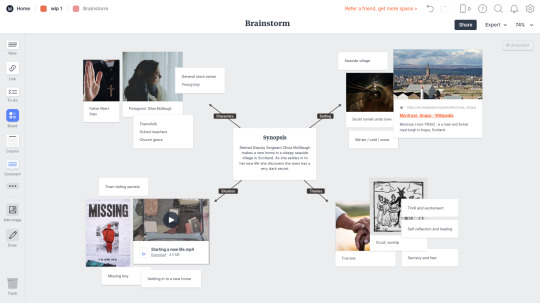
Here you can make a mind map of anything that comes up during the brainstorming process. This template has the synopsis at the center which I like to fill with at least one sentence of what I want to write even if it's likely to change later. The suggested sections of the web are "Characters" "Setting" "Situation" and "Themes" but you could organize however you wanted just like all of Milanote--the templates are handy but not prescriptive!
Moodboard

As seen above in the example, the moodboard can be used to collect themes and ideas for a cover. Personally, I like having this space separate from the brainstorm where I can go heavy on the "vibes". Anything that reminds me of my book goes here even if it's just because it has the same emotion of what I want to convey in my writing.
Story map
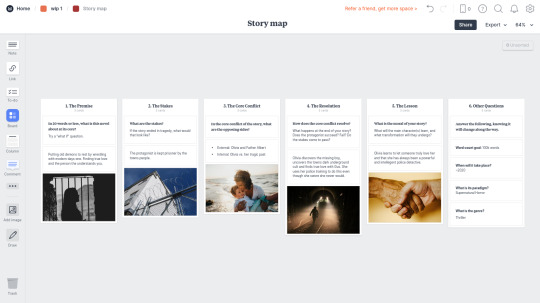
The story map is excellent for refining the idea behind your book before you start writing, especially if you're not a pantser but a plotter. Questions you can fill out or add your own are: the premise, the sakes, the core conflict, the resolution, the lesson, and data like word count goal, and genre.
Outline

For every main scene in my book, I like to give it a place on the outline. This includes a brief bullet point or two of where I think it's heading (although I'm willing to deviate from the plan).
Plot
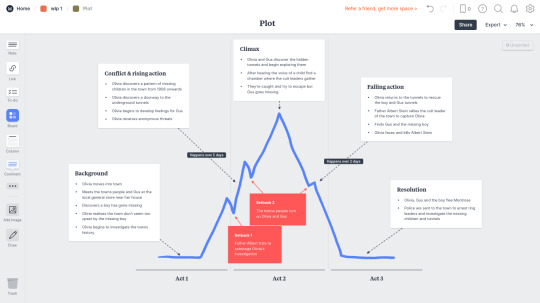
This is what first drew me into using Milanote to craft my novels! I found whenever I tried to plot out stories using the three-act structure I always ran out of room on pen and paper or even corkboards and sticky notes. Here I have so much more freedom to move and drop things around.
World building

When I have read all the information I mapped out as needing to research in the "Research" board, I decide what is going to make it into my world building. Here I develop everything from demography to food to a map of the area. You might not think you will need to focus on world building when you're writing about a real-world place but it helps so much to be familiar with every place if you want to capture authenticity!
Characters
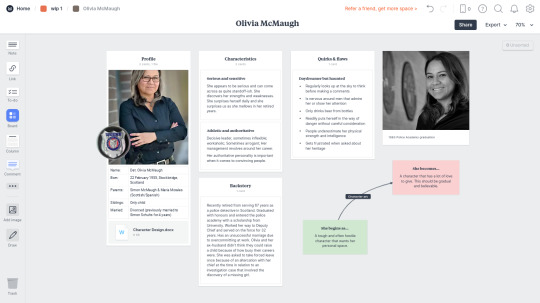
Here is where I make a quick fact file of all the key details of each of my characters. I also solidify their backstory, characteristics, quirks, and character arc. If you have a face claim of your character or art this is where you could put it too.
Character relationships

With even a handful of characters, it can become tricky to keep them and their relationships straight in your head. I use this page to note interactions such as friends/allies, siblings/married/child, and enemies.
If you've read this far thank you for sticking to the end! Just as a reminder, here is the link to Milanote using my referral. I don't get paid for this, but in exchange for this tutorial, I'm being given the upgrade to unlimited space. To the anon, I hope this is what you were looking for, and if you have any more questions, don't hesitate to ask!
482 notes
·
View notes
Text
This is a friendly reminder to never, ever publish your book with a publishing company that charges you to publish with them. That is a vanity press, which makes money by preying on authors. They charge you for editing, formatting, cover art, and more. With most of these companies, you will never seen a cent of any royalties made from sale of your book. A legitimate publishing company only makes money when you make money, they will never charge you to publish with them. If a company approaches you and says "Hey, we'll publish your book, just pay us X amount of money," tell them to go fuck themself and block them.
49K notes
·
View notes
Text

A List of Death Symbols
Is your character headed for endless slumber? Here are some red flags to plant within the story:
Skulls and bones
Candles
Cross
Latin Cross
All black/white clothing
Thanatos
Keres
Yama
Ankou
The Fourth Horseman
Banshees
Osiris
Grim Reaper
Giltine
Black Butterfly
Black cat
Bat
Vulture
Crow
Owl
Cypress trees
Red poppies
Hyacinths
Chrysanthemums
Lilies
If you like my blog, buy me a coffee☕ and find me on instagram! 📸
🖱️References
https://www.pinterest.com/pin/139330182215001295/
247 notes
·
View notes
